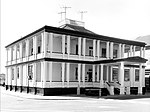Anacostia Pool riot
The Anacostia Pool riot took place on June 29, 1949, at a recently-desegregated public swimming pool in the Anacostia neighborhood of Washington, D.C. After two days of tense confrontations between white and black patrons of the pool, a two-hour large-scale disturbance involving 450 people resulted in five arrests and at least four serious injuries. Bill Mabry, one of the black swimmers involved, called the incident “Washington’s first race riot.” Despite pressure to relax the enforcement of the federal government’s nonsegregation policy, the Department of the Interior stated that “no backward step of any sort should be made in effectuating the President’s Civil Rights program,” specifically with respect to Washington, DC.
Excerpt from the Wikipedia article Anacostia Pool riot (License: CC BY-SA 3.0, Authors).Anacostia Pool riot
Anacostia Riverwalk Trail, Washington
Geographical coordinates (GPS) Address Nearby Places Show on map
Geographical coordinates (GPS)
| Latitude | Longitude |
|---|---|
| N 38.869388888889 ° | E -77.000222222222 ° |
Address
Anacostia Riverwalk Trail
Anacostia Riverwalk Trail
20388 Washington
District of Columbia, United States
Open on Google Maps










